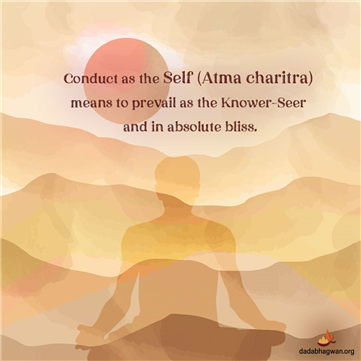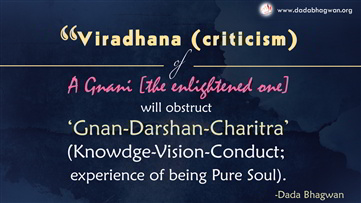Spiritual Quotes On charitra
Chastity of conduct (vyavahaar charitra) means one conducts himself in such a way that no woman is hurt by him, he does not look at any woman with a sexual intent.
Param Pujya Dada BhagwanThe greatest earning of all is that of conduct (charitra). When one’s conduct becomes strong [free of sexuality], then the world has been won over!
Param Pujya Dada BhagwanWhen the body [conduct that is visible through the five senses] becomes well-behaved, that is known as vyavahaar charitra (worldly conduct). When the Self becomes ‘well-behaved’ [remains within its inherent nature,] that is known as Nishchay Charitra (Conduct as the Self). When the Self becomes ‘well-behaved’, It is known as the Knower-Seer. ‘It’ remains only in absolute bliss. ‘It’ does not get involved in anything else.
Param Pujya Dada BhagwanWhat can be referred to as vyavahaar charitra (worldly conduct)? Those who are on the path described by the absolutely detached (vitaraag) Lords have this. When one is on the path described by the absolutely detached Lords, he does not consider other religions to not be his own; nevertheless, he maintains his own goal to attain the vitaraag dharma (the religion prescribed by the absolutely detached Lords, which is at 360 degrees, is impartial, incorporates all viewpoints, does not hurt anyone else's viewpoint or religion). He has faith in the absolutely detached Lords and he is not unjust towards anyone else. When there is no abhorrence towards any religion or any person, that is referred to as vyavahaar charitra!
Param Pujya Dada BhagwanEverything is filled within this body; anger, joy, sorrow. However, when the Self does not become engrossed in that and when every circumstance of the pudgal (non-Self complex of input and output) is Known as an effect of the non-Self (parparinaam), that is considered Conduct as the Self (samyak Charitra)!
Param Pujya Dada BhagwanKnowledge, Vision, and Conduct (Gnan-Darshan-Charitra) do not have form, they are formless. People are looking for that which has form; they are looking for that which is directly visible. Knowledge, Vision, and Conduct are not visible. The God that the vitaraag Lords have referred to has no form; He is formless. The One who wants to go to moksha (ultimate liberation) will have to accept what the vitaraag Lords have said!
Param Pujya Dada BhagwanThe Conduct as the Self (Charitra) that has manifest, what is that like? It can be measured by the extent to which one’s inner suffering has diminished!
Param Pujya Dada BhagwanConduct that is free of anger, pride, deceit, and greed (kashay) is Conduct that leads towards the Real (samyak Charitra) and absolute Conduct as the Self (keval Charitra) is the ultimate Conduct.
Param Pujya Dada BhagwanThe Self is aroopi (formless; imperceptible). That which is visible through the eyes is all an illusion (bhranti). The Real can be Seen through the divya chakshu (divine eyes) that, ‘This is God, and this is not God.’ The two parts can be Seen as separate. God is amurt (invisible), which means that He cannot be Seen through the eyes, through something that has form (roopi). God can be Known through the Knowledge that is beyond the sense organs (aroopi Gnan), He can be recognized through His Conduct as the Self (Charitra).
Param Pujya Dada BhagwanThere are four pillars of liberation (moksha): Knowledge (Gnan), Vision (Darshan), Conduct as the Self (Charitra) and penance (tapa). In this, the Lord has not referred to external penance as penance for liberation. 'He' has referred to inner penance only as the penance for liberation.
Param Pujya Dada Bhagwansubscribe your email for our latest news and events











